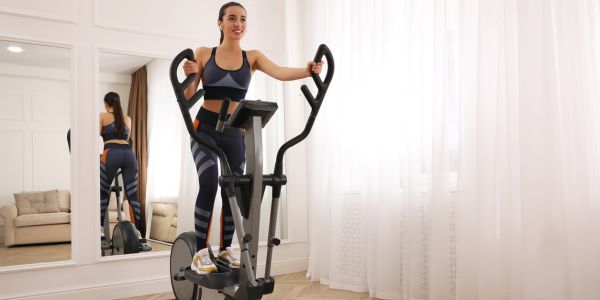Did you ever pedal backwards on an elliptical? Your body feels and acts completely differently.
This movement targets “your muscles” differently, you get a different caloric burn, and even different benefits. And of course, there are some pro tips you should follow to maximize your results.
Let’s dive right in.
What does pedaling backwards do for your muscles?
When you front pedal on the cross trainer, you notice your butt and core contracting quite vigorously. If you do a conscious effort to push with your arms, you feel the burn there too.
But once you start pedaling backwards, you notice that:
Your quads make an even more intense effort.
Your calves begin to fire up.
Your core can feel slightly less engaged, so you must remember to keep it engaged.
Your arms work less hard too, but you feel more of a burn in your triceps if you contract them.
This change in movements is very important because it allows you to understand you can consciously change the way your body moves. That means you can target different muscles better while on the elliptical.
That brings us to our pro tips.
1. Land in different ways.
When you’re at the bottom of that circular motion, it’s important where you put pressure on your sole. If you land more on the front of your soles (aka toes and midsole), your quads must work harder. If you land more on your heels, the hamstrings, calves, and butt work more.
2. Use your arms consciously.
When you’re on the elliptical for the first time, you tend to use it like a bike. That means your legs tend to do most of the work while your arms simply tag along, holding onto the handlebars. Instead, focus on consciously letting your arms take most of the weight your legs are handling. That’s when you’ll start feeling your triceps, biceps, and chest working out like mad.
3. Continue to consciously listen to your body and do micro-adjustments during the backward intervals.
Contract different muscle groups and try different grips and steps to activate specific muscles. For example, you can try slowly letting go of the handlebars when pedaling backwards. Or even forward for that matter. You’ll feel your core immediately engage, which sculpts your abs like a charm.
After the workout is over, you’ll be pretty much done too.
Other benefits of pedaling backwards
Now you understand what pedaling backwards on the elliptical does for your muscles. You also know how to maximize your results.
That brings us to my next point: the science-backed benefits of pedaling backwards.
1. It helps you train comprehensively
Muscles are made of fibers. These fibers run in different directions.
For example, your hamstrings run from your glutes to your knees, which results in movement in that plane.
But the fibers in your hamstrings have different angles. And that’s valid for all muscle groups in your body.
So even if the movement stays in a specific plane, you want to work your muscles from different angles.
Otherwise, you’d only be building strength for a specific range of motion and a specific muscle area. But when you work your muscles from different angles, you’ll tone the entire muscle.
That’s what pedaling backwards on the elliptical does; it helps tone your muscles comprehensively from all angles so you can avoid fitness plateaus and keep toning correctly.
2. It boosts cardiovascular endurance and burns more calories
Recent research proves that pedaling backwards increases your heart rate significantly. The reason might be your muscles make more effort to move in this plane.
And that means they also consume more calories.
For example, a study in the American Council on Exercise tested heart rate and oxygen consumption (VO2) for people pedaling forwards and back.
The backward movement increased participants’ heart rates by 8 points.
Besides, their quads were 17.5% more active and their outer thigs (vastus lateralis) worked harder by 11.1%. Even the rectus femoris, the muscle running from the hip to the knee saw a 13.1% increase in the backward pedaling.
That means pedaling backwards helps you tone those muscles, which in turn, raises your heart rate significantly. And that leads to a) better aerobic conditioning and b) increased caloric burn.
3. It improves brain function
Multiple studies show that exercise – especially aerobic exercise – improves brain function.
According to research published in Comprehensive Physiology, “More active or higher fit individuals are capable of allocating greater attentional resources toward the environment and are able to process information more quickly. These data are suggestive that aerobic fitness enhances cognitive strategies enabling to respond effectively to an imposed challenge with a better yield in task performance.”
And we already showed that pedaling backwards on the elliptical is amazing for your aerobic capacity.
But that’s not all.
Alternating between pedaling forwards and backwards on the elliptical machine can improve brain function by engaging different parts of the brain and promoting neuroplasticity. Neuroplasticity is the brain’s ability to adapt and change in response to new experiences and stimuli.
And improving your neuroplasticity impacts your brain positively, improving your working memory, attention control, and task switching.
4. It improves your posture
Pedaling backwards improves your posture.
If you remember to contract your core muscles consciously during the movement.
And if you pedal without the handles, your core will be even more engaged.
That’s how you strengthen your midsection correctly. Having that stronger core helps you maintain a neutral spine and a correct body posture.
Keeping an aligned, neutral spine and correct posture minimizes future potential back or neck pain. It helps you decrease the risk of injury as you age and it makes you look and feel better.
5. Pedaling backwards helps you prevent and recover from injuries.
Training your body comprehensively prevents muscle imbalances.
Those imbalances don’t just affect the muscles. They also affect your tendons and joints because pulling on just one specific part of the muscles creates tension on one part of the joints.
Well, alternating front pedaling with pedaling backwards keeps a balanced tension around your joints. And it increases your range of motion.
And here’s another thing:
Pedaling backwards is milder on your knees and ankles if you have specific conditions.
A study in the Journal of Clinical biomechanics says that backward pedaling reduces tibiofemoral comrpessive loads. That means your knee joint is under less pressure, which is best for people with menisci damage and osteoarthritis.
However, the same study notes higher patellofemoral compression – that’s the front of the knee, around your knee cap. That’s why the researchers don’t recommend backward pedaling for people with patellofemoral pain, cruciate ligament injury, or reconstruction.
So, after watching all this, you know the science-backed benefits of pedaling backwards on the elliptical and how to use this exercise to improve muscle strength.
I’m curious if you ever tried this exercise before and what you think of it.
- 7 Exercises for Pregnant Women in the First Trimester: Safe and Effective - January 30, 2025
- Our equipment recommendations - October 30, 2024
- Here’s What Doing Cardio Every Day Does To Your Body - August 21, 2024

